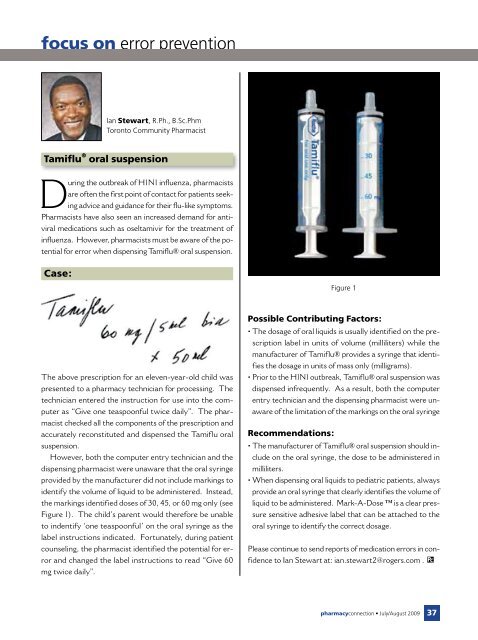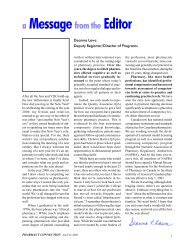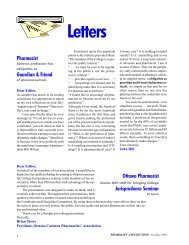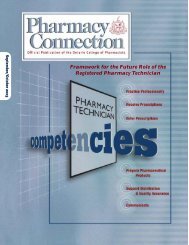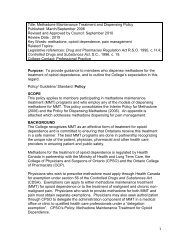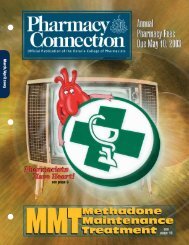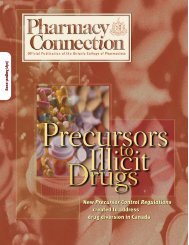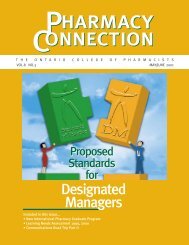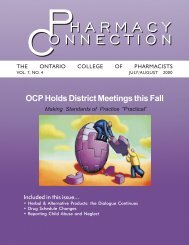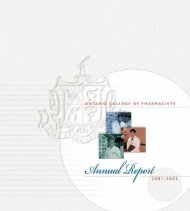Understand the Culture in Which You Practise Hyperthermia: Are ...
Understand the Culture in Which You Practise Hyperthermia: Are ...
Understand the Culture in Which You Practise Hyperthermia: Are ...
You also want an ePaper? Increase the reach of your titles
YUMPU automatically turns print PDFs into web optimized ePapers that Google loves.
focus on error prevention<br />
Ian Stewart, R.Ph., B.Sc.Phm<br />
Toronto Community Pharmacist<br />
Tamiflu ® oral suspension<br />
Dur<strong>in</strong>g <strong>the</strong> outbreak of H1N1 <strong>in</strong>fluenza, pharmacists<br />
are often <strong>the</strong> first po<strong>in</strong>t of contact for patients seek<strong>in</strong>g<br />
advice and guidance for <strong>the</strong>ir flu-like symptoms.<br />
Pharmacists have also seen an <strong>in</strong>creased demand for antiviral<br />
medications such as oseltamivir for <strong>the</strong> treatment of<br />
<strong>in</strong>fluenza. However, pharmacists must be aware of <strong>the</strong> potential<br />
for error when dispens<strong>in</strong>g Tamiflu® oral suspension.<br />
Case:<br />
Figure 1<br />
The above prescription for an eleven-year-old child was<br />
presented to a pharmacy technician for process<strong>in</strong>g. The<br />
technician entered <strong>the</strong> <strong>in</strong>struction for use <strong>in</strong>to <strong>the</strong> computer<br />
as “Give one teaspoonful twice daily”. The pharmacist<br />
checked all <strong>the</strong> components of <strong>the</strong> prescription and<br />
accurately reconstituted and dispensed <strong>the</strong> Tamiflu oral<br />
suspension.<br />
However, both <strong>the</strong> computer entry technician and <strong>the</strong><br />
dispens<strong>in</strong>g pharmacist were unaware that <strong>the</strong> oral syr<strong>in</strong>ge<br />
provided by <strong>the</strong> manufacturer did not <strong>in</strong>clude mark<strong>in</strong>gs to<br />
identify <strong>the</strong> volume of liquid to be adm<strong>in</strong>istered. Instead,<br />
<strong>the</strong> mark<strong>in</strong>gs identified doses of 30, 45, or 60 mg only (see<br />
Figure 1). The child’s parent would <strong>the</strong>refore be unable<br />
to <strong>in</strong>dentify ‘one teaspoonful’ on <strong>the</strong> oral syr<strong>in</strong>ge as <strong>the</strong><br />
label <strong>in</strong>structions <strong>in</strong>dicated. Fortunately, dur<strong>in</strong>g patient<br />
counsel<strong>in</strong>g, <strong>the</strong> pharmacist identified <strong>the</strong> potential for error<br />
and changed <strong>the</strong> label <strong>in</strong>structions to read “Give 60<br />
mg twice daily”.<br />
Possible Contribut<strong>in</strong>g Factors:<br />
• The dosage of oral liquids is usually identified on <strong>the</strong> prescription<br />
label <strong>in</strong> units of volume (milliliters) while <strong>the</strong><br />
manufacturer of Tamiflu® provides a syr<strong>in</strong>ge that identifies<br />
<strong>the</strong> dosage <strong>in</strong> units of mass only (milligrams).<br />
• Prior to <strong>the</strong> H1N1 outbreak, Tamiflu® oral suspension was<br />
dispensed <strong>in</strong>frequently. As a result, both <strong>the</strong> computer<br />
entry technician and <strong>the</strong> dispens<strong>in</strong>g pharmacist were unaware<br />
of <strong>the</strong> limitation of <strong>the</strong> mark<strong>in</strong>gs on <strong>the</strong> oral syr<strong>in</strong>ge<br />
Recommendations:<br />
• The manufacturer of Tamiflu® oral suspension should <strong>in</strong>clude<br />
on <strong>the</strong> oral syr<strong>in</strong>ge, <strong>the</strong> dose to be adm<strong>in</strong>istered <strong>in</strong><br />
milliliters.<br />
• When dispens<strong>in</strong>g oral liquids to pediatric patients, always<br />
provide an oral syr<strong>in</strong>ge that clearly identifies <strong>the</strong> volume of<br />
liquid to be adm<strong>in</strong>istered. Mark-A-Dose is a clear pressure<br />
sensitive adhesive label that can be attached to <strong>the</strong><br />
oral syr<strong>in</strong>ge to identify <strong>the</strong> correct dosage.<br />
Please cont<strong>in</strong>ue to send reports of medication errors <strong>in</strong> confidence<br />
to Ian Stewart at: ian.stewart2@rogers.com .<br />
pharmacyconnection • July/August 2009<br />
37


